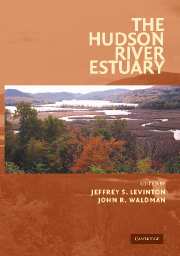Book contents
- Frontmatter
- Contents
- Preface
- List of Contributors
- The Hudson River Estuary
- 1 The Hudson River Estuary: Executive Summary
- GEOLOGICAL, PHYSICAL, AND CHEMICAL SETTING OF THE HUDSON
- 2 The Hudson River Valley: Geological History, Landforms, and Resources
- 3 The Physical Oceanography Processes in the Hudson River Estuary
- 4 Sedimentary Processes in the Hudson River Estuary
- 5 Benthic Habitat Mapping in the Hudson River Estuary
- 6 Reconstructing Sediment Chronologies in the Hudson River Estuary
- 7 Major Ion Geochemistry and Drinking Water Supply Issues in the Hudson River Basin
- PRIMARY PRODUCTION, MICROBIAL DYNAMICS, AND NUTRIENT DYNAMICS OF THE HUDSON
- HUDSON RIVER COMMUNITIES, FOOD WEBS, AND FISHERIES
- CONTAMINANTS AND MANAGEMENT ISSUES OF THE HUDSON RIVER ESTUARY
- Index
- Plate section
- References
5 - Benthic Habitat Mapping in the Hudson River Estuary
Published online by Cambridge University Press: 06 January 2010
- Frontmatter
- Contents
- Preface
- List of Contributors
- The Hudson River Estuary
- 1 The Hudson River Estuary: Executive Summary
- GEOLOGICAL, PHYSICAL, AND CHEMICAL SETTING OF THE HUDSON
- 2 The Hudson River Valley: Geological History, Landforms, and Resources
- 3 The Physical Oceanography Processes in the Hudson River Estuary
- 4 Sedimentary Processes in the Hudson River Estuary
- 5 Benthic Habitat Mapping in the Hudson River Estuary
- 6 Reconstructing Sediment Chronologies in the Hudson River Estuary
- 7 Major Ion Geochemistry and Drinking Water Supply Issues in the Hudson River Basin
- PRIMARY PRODUCTION, MICROBIAL DYNAMICS, AND NUTRIENT DYNAMICS OF THE HUDSON
- HUDSON RIVER COMMUNITIES, FOOD WEBS, AND FISHERIES
- CONTAMINANTS AND MANAGEMENT ISSUES OF THE HUDSON RIVER ESTUARY
- Index
- Plate section
- References
Summary
abstract Successful management of underwater lands requires detailed knowledge of the terrain and the interrelationships between landscape and habitat characteristics. While optical techniques can be used where the water is shallow or clear, other techniques are needed where the water is deeper or where optical transmission is limited by water clarity. Marine geophysical techniques provide quantitative measures of the nature of the estuary floor that can provide constraints on the distribution and movement of contaminated sediments as well as the nature of benthic habitats. The Benthic Mapping Program, supported by the Hudson River Estuary Program of the New York State Department of Environmental Conservation (NYSDEC) and the Hudson River Action Project, is being conducted in the Hudson River to characterize the river bed from the Verrazano Narrows in New York Harbor to the Federal Dam at Troy, New York. The study is using a range of acoustic and sampling techniques to gain new information on the river bed. The first phase of the Benthic Mapping Program, which occurred from 1998 to 2000, focused on four areas (about 40 river miles; 65 km). The products from the study have been incorporated into a GIS data management system for NYSDEC (see http://benthic.info for the DEC Benthic Mapper web site, an online version of the GIS database). This effort, supplemented by studies of benthic fauna and bathymetric change, is being continued under NYSDEC support for the remainder of the Hudson River. The second phase of the program worked in four areas in 2001 and 2002 (about 35 river miles; 57 km) and we completed the study by working in three areas in 2003 (about 66 river miles; 121 km).
- Type
- Chapter
- Information
- The Hudson River Estuary , pp. 51 - 64Publisher: Cambridge University PressPrint publication year: 2006
References
- 5
- Cited by



